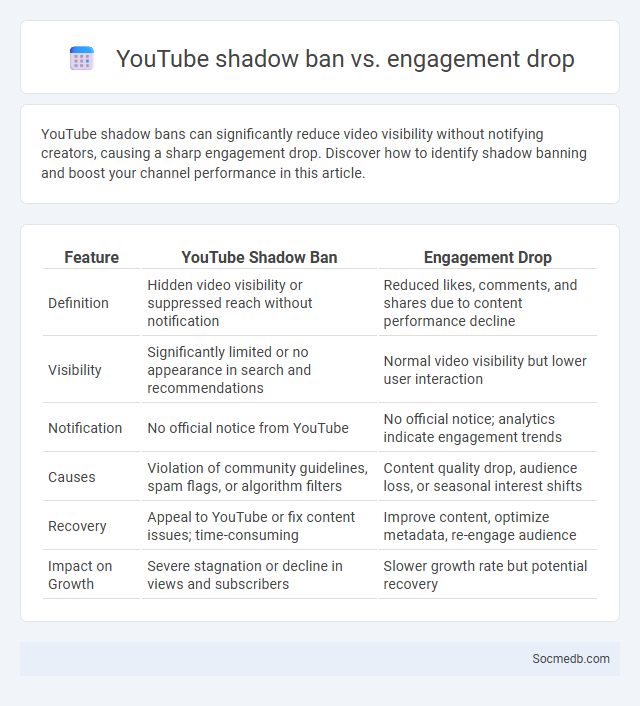
Photo illustration: YouTube shadow ban vs engagement drop
YouTube shadow bans can significantly reduce video visibility without notifying creators, causing a sharp engagement drop. Discover how to identify shadow banning and boost your channel performance in this article.
Table of Comparison
| Feature | YouTube Shadow Ban | Engagement Drop |
|---|---|---|
| Definition | Hidden video visibility or suppressed reach without notification | Reduced likes, comments, and shares due to content performance decline |
| Visibility | Significantly limited or no appearance in search and recommendations | Normal video visibility but lower user interaction |
| Notification | No official notice from YouTube | No official notice; analytics indicate engagement trends |
| Causes | Violation of community guidelines, spam flags, or algorithm filters | Content quality drop, audience loss, or seasonal interest shifts |
| Recovery | Appeal to YouTube or fix content issues; time-consuming | Improve content, optimize metadata, re-engage audience |
| Impact on Growth | Severe stagnation or decline in views and subscribers | Slower growth rate but potential recovery |
Understanding YouTube Shadow Banning
YouTube shadow banning occurs when the platform restricts a channel's visibility without notifying the creator, causing videos to receive significantly fewer views and limited engagement. This practice impacts content discoverability by suppressing videos in search results, recommended feeds, and subscriber notifications, often due to algorithmic detection of policy violations or suspicious activities. Understanding the signs of shadow banning, such as drastic drops in traffic and lack of interaction, helps creators adjust content strategies to comply with YouTube's community guidelines and regain organic reach.
What Is an Engagement Drop on YouTube?
An engagement drop on YouTube refers to a significant decline in viewer interactions such as likes, comments, shares, and watch time on a video or channel. This decrease can impact the algorithm's promotion of content, reducing visibility and subscriber growth. Factors influencing engagement drops include changes in audience interest, content relevance, upload frequency, and shifts in YouTube's algorithm.
Shadow Ban vs Engagement Drop: Key Differences
Shadow ban on social media restricts the visibility of Your content without notification, causing a significant drop in reach and interaction. Engagement drop occurs when followers naturally lose interest or activity decreases, leading to fewer likes, comments, and shares. Identifying a shadow ban involves checking analytics for sudden, unexplained declines, while engagement drop reflects gradual audience behavior changes.
Common Signs of Being Shadow Banned on YouTube
Shadow banning on YouTube often results in a sudden and unexplained drop in video views and engagement metrics, including likes and comments. Content creators may notice their videos not appearing in search results or related video suggestions, significantly reducing organic reach. Frequent inability to access channel analytics and a lack of notifications about subscriber activity are additional common signs of being shadow banned.
Reasons Behind YouTube Engagement Drops
Social media engagement on YouTube often declines due to algorithm changes that prioritize longer watch times and content freshness, affecting visibility and reach. Audience fatigue from repetitive content and shifts in viewer preferences toward short-form videos like YouTube Shorts also contribute to reduced interaction rates. Competition from alternative platforms with innovative features diverts user attention, causing noticeable drops in likes, comments, and overall engagement metrics.
How the YouTube Algorithm Handles Content
The YouTube algorithm prioritizes content based on user engagement metrics such as watch time, click-through rate, and viewer retention, ensuring videos that captivate audiences appear more frequently in recommendations. It analyzes your viewing history and preferences to personalize video suggestions, maximizing relevance and viewer satisfaction. Understanding this system helps creators optimize titles, thumbnails, and metadata to enhance visibility and reach on the platform.
Diagnosing Shadow Banning on Your Channel
Diagnosing shadow banning on your social media channel involves monitoring sudden drops in engagement metrics such as likes, comments, and shares, which may indicate restricted content visibility. Use analytics tools to track reach and impressions for patterns inconsistent with your usual performance. Checking platform-specific community guideline alerts or communications can help confirm if shadow banning is impacting your channel's exposure.
How to Recover from a Shadow Ban on YouTube
To recover from a shadow ban on YouTube, users should first identify if restrictions are in place by checking video visibility and engagement metrics. Reviewing and adhering to YouTube's community guidelines, removing any content that violates policies, and avoiding spammy behavior significantly improve recovery chances. Engaging with the YouTube Support team for appeals and maintaining consistent, high-quality content can restore channel visibility and audience reach.
Boosting Channel Engagement After a Decline
To boost your channel engagement after a decline, analyze recent content performance metrics to identify what resonates most with your audience. Implement targeted strategies such as interactive polls, timely responses to comments, and consistent posting schedules tailored to your followers' peak activity times. Leveraging these data-driven tactics helps restore visibility, foster community interaction, and drive sustained growth on your social media platform.
Preventative Strategies Against Shadow Banning and Engagement Drops
Implementing transparent content guidelines and actively monitoring algorithm changes are essential preventative strategies against shadow banning on social media platforms. Utilizing diversified content formats and maintaining consistent posting schedules help sustain user engagement and mitigate sudden drops. Employing analytics tools to track audience behavior enables timely adjustments that preserve visibility and interaction.
 socmedb.com
socmedb.com